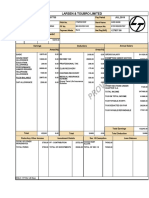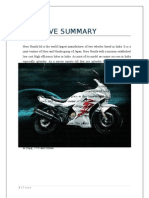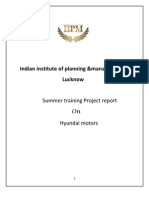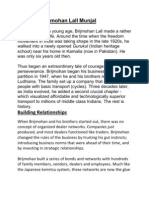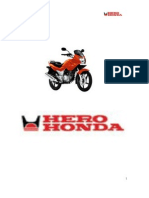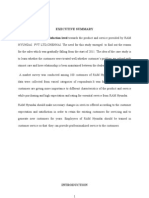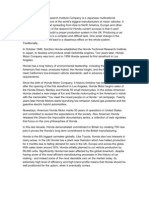Hero Honda - Docx1
Hero Honda - Docx1
Uploaded by
Singh ViratCopyright:
Available Formats
Hero Honda - Docx1
Hero Honda - Docx1
Uploaded by
Singh ViratOriginal Description:
Original Title
Copyright
Available Formats
Share this document
Did you find this document useful?
Is this content inappropriate?
Copyright:
Available Formats
Hero Honda - Docx1
Hero Honda - Docx1
Uploaded by
Singh ViratCopyright:
Available Formats
Hero Honda's company profile The joint venture between India's Hero Group and Honda Motor Company,
Japan has not only created the world's single largest two wheeler company but also one of the most successful joint ventures worldwide. During the 80s, Hero Honda became the first company in India to prove that it was possible to drive a vehicle without polluting the roads. The company introduced new generation motorcycles that set industry benchmarks for fuel thrift
and low emission. A legendary 'Fill it - Shut it Forget it' campaign captured the imagination of commuters across India, and Hero Honda sold millions of bikes purely on the commitment of increased mileage. Over 20 million Hero Honda two wheelers tread Indian roads today. These are almost as many as the number of people in Finland, Ireland and Sweden put together! HERO HONDA'S MANDATE Hero Honda is a world leader because of its excellent manpower, proven management, extensive
dealer network, efficient supply chain and worldclass products with cutting edge technology from Honda Motor Company, Japan. The teamwork and commitment are manifested in the highest level of customer satisfaction, and this goes a long way towards reinforcing its leadership status. FROM THE CHAIRMAN'S DESK LEADING WITH A DREAM We had a dream. The dream of making motorcycles that would touch and transform the
lives of our customers by giving them a mode of transport that was fuelefficient, comfortable and environment friendly. One that would enhance their efficiency at work, enable them to share moments of joy with their families and add up to a better quality of life. In a scenario where the customer had a few choices, our vision was to offer the highest quality at a reasonable price, to meet our customers expectations, and to exceed them. Behind the success of Hero Honda, is the saga of team-work. We would like to acknowledge
the role played by our JV partners, Honda Motor Company, Japan, and all our business associates, shareholders and employees. ABOUT THE CHAIRMAN Brijmohan Lall Munjal Seeding a Dream "Don't dream if you can't fulfill your dreams'' Brijmohan Lall Munjal is often fond of saying. The founder and patriarch of the $ 2.8 billion Hero Group is your classic first generation entrepreneur. He is a man who started small, dreamt big and used a combination of grit and perseverance to create one of the country's
largest corporate groups and the World's No.1 Two Wheeler Company. Instinctive from a young age, Brijmohan Lall made a rather unusual start in life. Around the time when the freedom movement in India was taking shape in the late 1920s, he walked into a newly opened Gurukul (Indian heritage school) near his home in Kamalia (now in Pakistan). He was only six years old then.
seminar flower
Super Moderator
He
RE: Project on Hero Ho
Hero Honda
HERO HONDA (1).doc (Size: 1.21 MB / Downloads: 30) INTRODUCTION The rapid pace of information flow and enhanced international communication links are transforming the markets worldwide. In todays competitive business environment, achieving customer satisfaction is a key element in setting the business goals and objectives of the corporate. Improving value based service delivery and responsiveness to the customers has become a source of competitive advantage in
service sectors. In healthy economies successful and prosperous corporations coexist with one another in intensely markets in a state of vigorous and creative tension. Organizations create new value for society by continuously creating innovative new products and services and by finding between ways to make and offer existing ones: competitive markets, on the other hand, relentlessly for the same organization, to surrender most of the value of others. Conventional marketing efforts centered around the four Ps of marketing i.e. Product, Price, Place, Promotion have long influenced those responsible for the sale of consumer and
industrial products, with the primary objectives of building market share. The new marketing concept, on the other hand, focuses on strategic planning and quality with emphasis on customer analysis, total quality management and distinctive competence. Customer Delight and satisfaction: Customer satisfaction is the level of persons felt state resulting from comparing a products perceived performance in relation to customers expectations. In other words, the satisfaction level is a function of the difference between perceived performance and expectation. In todays
competitive business environment, successful organizations are raising expectations of the customers and are delivering actual performance to match those expectations. Customer value: Slowly but surely companies are entering a new era of customer relationship management (CRM). This time it will be the real thing. Not just an acronym. Not just glorified customer service. This time, it will bring real bottom-line impact and value to the company as well as to the customer. Customer value is the got topic right now. Long before the term customer relationship management (CRM) was coined,
companies battled to be the best at understanding and serving their customer. That hasnt changed. But much else has changed in technologies; business processes, organization models and customers themselves have fundamentally. Affected the marketing, sales and service continuum the customer relationship landscape. And new customer strategies will be built on a platform of new technology capabilities. Customer value management will be a win-win proposition. The focus on the customer remains, but business will simultaneously step up their efforts to gain value for themselves as well as for customers.
NEED FOR THE STUDY Todays companies are facing their toughest competition ever. Too many companies think that is the marketing or sales departments job to procure customer. If they cannot, the company draws conclusion that is marketing people isnt very good. But, In fact, marketing is only one factor in attracting and keeping customers. The best marketing department in the world cannot sell products that are poorly made or ail to meet anyones need. The marketing department can be effective only in companies whose various department and employees have designed and implemented competitively
superior customer valuedelivery system. Todays customers face a vast array of product and brand choice, prices and suppliers. We believe that customers estimate which offer will deliver the most value. Customers are the value maximizes, with in the bounds of search costs and limited knowledge, mobility and income. They form an expectation of value and act on it. Whether or not the offer lives up to the value expectation both satisfaction and repurchases probability. INDUSTRY PROFILE India is the second largest manufacturer and producer of twowheelers in the world. It stands next only to
Japan and China in terms of the number of twowheelers produced and domestic sales respectively. This distinction was achieved due to variety of reasons like restrictive policy followed by the Government of India towards the passenger car industry, rising demand for personal transport, inefficiency in the public transportation system etc. The Indian twowheeler industry made a small beginning in the early 50s when Automobile Products of India (API) started manufacturing scooters in the country. Until 1958, API and Enfield were the sole producers. In 1948, Bajaj Auto began trading in imported Vespa scooters and three-wheelers. Finally, in 1960,
it set up a shop to manufacture them in technical collaboration with Piaggio of Italy. The agreement expired in 1971. In the initial stages, the scooter segment was dominated by API; it was later overtaken by Bajaj Auto. Although various government and private enterprises entered the fray for scooters, the only new player that has lasted till today is LML.
seminar flower
Super Moderator
He
RE: Project on Hero Ho
Hero Honda
Hero
Honda.ppt (Size: 1,004 KB / Downloads: 18) BACKGROUND Formed in 1984 as a JV between Munjal Brothers & Honda Motors (both own 26 % each). Worlds No.1 two-wheeler company , in terms of unit volume sales. Worlds Largest Manufacturer of two-wheelers. Every second motorcycle bought in India is a Splendor Hero Hondas top-selling bike. Hero to pay Honda $1 billion , 30 50 % of the actual worth , through offmarket transaction deals. REASONS FOR THE SPLIT Bharat norm IV would have to be implemented. Greater investment in technology , in turn.
Lower profit margins and increasing R&D and loyalty costs. Hero wants to create their own identity in the global market. KEY ISSUES Future of the group Transition from Hero Honda to Hero Market share decline Retaining core customer group Increasing R&D and raw materials costs New launches by competitors Local markets response decrease Export numbers declining Fresh branding initiatives MARKET SHARE DECLINE Exploring possibilities of entry-level launches at lower prices compared to its competitors.
Three full years to develop their own capabilities and come up with entry-level models. High R&D and Cost Compensation Choosing an inhouse R&D team and not going for a domestic/foreign partner for technical collaboration will help in saving overhead costs. Hero could save up to 5500 crores on royalty for the financial year 2011. LOCAL MARKETS Focus has to be majorly on the domestic markets , where the main strength of Hero lies. Heros old Splendor and Passion models constitute 70 % of its sales ; all recent new bikes add up to only 8 % of sales.
EXPORTS Exports may not rise as fast as expected because it takes time to understand markets and to build supply chains. The Honda tag name cannot be used for exports. There will be an advantage if they export to particular locations where Honda already has a reputed name. More exports of motorcycles will be possible , since it was only limited to Indias neighboring countries till now. BRANDING Branding campaign needs to be completely revamped because people wouldnt be able to relate with the Hero group so easily. Technology
agreement between Hero and Honda bars Hero from using the Honda name if they decide to make changes to their current products. Hence , Hero has decided to rebrand. This is the reason they have asked JWT to help them out. Plans include using a new branding strategy for , on the lines of their Dhak Dhak Go and Fill It-Shut It-Forget It campaigns. Reinforcement of the new brand is the biggest key. 100 crore is being allotted by Hero to reconfigure their new brand name. Hero is planning to launch 3 new models using their own name, by the end of 2011 , with the first being a dirt bike.
NOW WHAT ? Hero is mainly picturised as a bicycle company , rather than a 2-wheeler organisation and creating a distinguishing shift in the peoples mind is most important. Advertisement like Marutis Ghar aa gaya Hindustan can be thought of , to connect with the Indian audience. Organize street shows and campaigns to create generic awareness among the people about the upcoming Hero products. Hero is reportedly hiring engineers from its competitors like Bajaj , Yamaha and Mahindra 2wheelers.
You might also like
- Outbound Hiring: How Innovative Companies are Winning the Global War for TalentFrom EverandOutbound Hiring: How Innovative Companies are Winning the Global War for TalentNo ratings yet
- Assignment 1.1 POT22003424Document7 pagesAssignment 1.1 POT22003424vineet panwar100% (2)
- Product Life CycleDocument36 pagesProduct Life CycleArun Narayanan71% (7)
- Hero Honda Project ReportDocument107 pagesHero Honda Project Reportswatantra awasthi88% (8)
- Analysis of Company FinalDocument27 pagesAnalysis of Company FinalAakash1994sNo ratings yet
- Marketing Strategy of Hero HondaDocument78 pagesMarketing Strategy of Hero Hondamathuriaanuradha100% (6)
- The Elegant Solution: Toyota's Formula for Mastering InnovationFrom EverandThe Elegant Solution: Toyota's Formula for Mastering InnovationRating: 4 out of 5 stars4/5 (4)
- PR MR PT Payslip GeneralDocument1 pagePR MR PT Payslip GeneralArun PVNo ratings yet
- 2009 Front End Conceptual Estimating YearbookDocument470 pages2009 Front End Conceptual Estimating YearbookGerardo Delgado100% (4)
- Is 14489 2018Document21 pagesIs 14489 2018Rohit100% (3)
- Basic Marketing AssignmentDocument25 pagesBasic Marketing AssignmentAboud Abdulla0% (1)
- Mbo HerohondaDocument22 pagesMbo HerohondavithanibharatNo ratings yet
- PBM Brand AuditDocument15 pagesPBM Brand Auditakankshya mishraNo ratings yet
- A Project Report On Market Potentiality of Hero Honda Splendor Plus in GADAG CITYDocument82 pagesA Project Report On Market Potentiality of Hero Honda Splendor Plus in GADAG CITYBabasab Patil (Karrisatte)No ratings yet
- PLC Hero HondaDocument34 pagesPLC Hero HondaArun Narayanan50% (2)
- Hero Honda ProjectDocument11 pagesHero Honda Projectjyoti_prakash_11No ratings yet
- Project Report On Hyundai Santro For MarketingDocument41 pagesProject Report On Hyundai Santro For MarketingAbhishek SrivastavaNo ratings yet
- A Project Report On "A Comparative Study Between Hero Honda Splendor+ and Its Competitors To Increase The Market Share in MUDHOL RegionDocument70 pagesA Project Report On "A Comparative Study Between Hero Honda Splendor+ and Its Competitors To Increase The Market Share in MUDHOL RegionBabasab Patil (Karrisatte)No ratings yet
- Ýccc C Ýccc C Ýcc C Ýcccc C Ýcccc Ýcc C Ýcc Ýcc C !C Ýc "C#C$C Ýc#c CC%#C &'C CDocument6 pagesÝccc C Ýccc C Ýcc C Ýcccc C Ýcccc Ýcc C Ýcc Ýcc C !C Ýc "C#C$C Ýc#c CC%#C &'C CashirsamoonNo ratings yet
- Arvind Arora (520813268)Document102 pagesArvind Arora (520813268)shraddhaNo ratings yet
- Brijmohan Lall MunjalDocument19 pagesBrijmohan Lall MunjalMj Payal100% (1)
- Hero Hond: Marketing and Human Resource ManagementDocument70 pagesHero Hond: Marketing and Human Resource Managementdhiraj022No ratings yet
- Project Report On Hero Honda by YOONAF ISHTIAQDocument54 pagesProject Report On Hero Honda by YOONAF ISHTIAQyoonaf55% (11)
- Project ReportDocument16 pagesProject Reportj_sachin09No ratings yet
- BS Project WorkDocument15 pagesBS Project WorkSangeethaNo ratings yet
- HondaDocument33 pagesHondaahmad frazNo ratings yet
- Advertising and Sales Promotion at Bharat Honda, KalaburagiDocument86 pagesAdvertising and Sales Promotion at Bharat Honda, Kalaburagikhsheth0% (1)
- Pruject 2Document90 pagesPruject 2vipin554100% (1)
- Minor Project. BbaDocument26 pagesMinor Project. Bbasafwanky17No ratings yet
- Customer Sat ReportDocument22 pagesCustomer Sat ReportVignesh SampathNo ratings yet
- Hero HondaDocument89 pagesHero HondaPiyush SoniNo ratings yet
- Assignment 1 BRAND: HondaDocument8 pagesAssignment 1 BRAND: HondaPradeep RajNo ratings yet
- Assignment 1: Submitted byDocument20 pagesAssignment 1: Submitted byayan ahmedNo ratings yet
- Marketing Mangement Project - Hero HondaDocument68 pagesMarketing Mangement Project - Hero Hondavinod sambraniNo ratings yet
- Hero Honda StudyDocument8 pagesHero Honda StudyAnshul JainNo ratings yet
- HERO Bikes FinalDocument8 pagesHERO Bikes FinalRadhika BhukaniaNo ratings yet
- Honda Motors Introduction and Its OperationDocument9 pagesHonda Motors Introduction and Its OperationSyed Husnain BokhariNo ratings yet
- Competitive Position AssignmentDocument3 pagesCompetitive Position AssignmentVaidant TomarNo ratings yet
- HondaDocument8 pagesHondaZakaria KassimiNo ratings yet
- Honda Activa and Hero PleasureDocument61 pagesHonda Activa and Hero PleasureRohit KumarNo ratings yet
- Mba ProjectDocument77 pagesMba ProjectManonmani ANo ratings yet
- CS Final Report - HondaDocument22 pagesCS Final Report - HondaAmna ImranNo ratings yet
- Hero ScribdDocument16 pagesHero ScribdApoorv KalraNo ratings yet
- Chapter: 1 Executive SummaryDocument58 pagesChapter: 1 Executive Summary1311991100% (1)
- Hero Honda Motors LTDDocument12 pagesHero Honda Motors LTDAashir AgrawalNo ratings yet
- Synopsis Hero Honda Car & SatisfactionDocument23 pagesSynopsis Hero Honda Car & SatisfactionbhatiaharryjassiNo ratings yet
- Project Report On Hyundai Santro For MarketingDocument41 pagesProject Report On Hyundai Santro For MarketingHarshad Patel33% (3)
- Executive Summary of Honda Motor CompanyDocument9 pagesExecutive Summary of Honda Motor CompanyYASH MANGLEKARNo ratings yet
- Case Study On HondaDocument10 pagesCase Study On HondaHussam MubashirNo ratings yet
- Honda Project ReportDocument12 pagesHonda Project ReportGaurav Muteja50% (2)
- HRM ProjectDocument14 pagesHRM ProjectProjectdenaNo ratings yet
- Sales & Distribution - Hero HondaDocument36 pagesSales & Distribution - Hero HondaLikumri ChangkiriNo ratings yet
- Company Profile HondaDocument6 pagesCompany Profile HondaShams SNo ratings yet
- Marketing and Sale in Reference To HondaDocument11 pagesMarketing and Sale in Reference To HondaSheikh FaizNo ratings yet
- BS Project ReportDocument18 pagesBS Project ReportVaibhav PagiaNo ratings yet
- A new era of Value Selling: What customers really want and how to respondFrom EverandA new era of Value Selling: What customers really want and how to respondNo ratings yet
- The Purchasing Machine: How the Top Ten Companies Use Best Practices to Manage Their Supply ChainsFrom EverandThe Purchasing Machine: How the Top Ten Companies Use Best Practices to Manage Their Supply ChainsRating: 3.5 out of 5 stars3.5/5 (6)
- Costovation: Innovation That Gives Your Customers Exactly What They Want--And Nothing MoreFrom EverandCostovation: Innovation That Gives Your Customers Exactly What They Want--And Nothing MoreNo ratings yet
- Cambridge O Level Business Studies 7115: Third EditionFrom EverandCambridge O Level Business Studies 7115: Third EditionNo ratings yet
- From Voices to Results - Voice of Customer Questions, Tools and Analysis: Proven techniques for understanding and engaging with your customersFrom EverandFrom Voices to Results - Voice of Customer Questions, Tools and Analysis: Proven techniques for understanding and engaging with your customersNo ratings yet
- The Great 8 Pillars: ROI-Driven Marketing for Manufacturing CompaniesFrom EverandThe Great 8 Pillars: ROI-Driven Marketing for Manufacturing CompaniesNo ratings yet
- Delhi, Capital of IndiaDocument32 pagesDelhi, Capital of IndiaSingh ViratNo ratings yet
- Unstructured Interview PDFDocument2 pagesUnstructured Interview PDFSingh ViratNo ratings yet
- Sunset Medical: A Statement of Cash Flow CaseDocument5 pagesSunset Medical: A Statement of Cash Flow CaseSingh ViratNo ratings yet
- Case Study A Financial Products Company 125042Document2 pagesCase Study A Financial Products Company 125042Singh ViratNo ratings yet
- The Nature of Secondary Sources of InformationDocument6 pagesThe Nature of Secondary Sources of InformationSingh ViratNo ratings yet
- CV Templates Curriculum VitaeDocument6 pagesCV Templates Curriculum VitaeSingh ViratNo ratings yet
- Table of Content Chapter-1Document4 pagesTable of Content Chapter-1Singh ViratNo ratings yet
- Further Reading: This Article Incorporates Text From The 1911 Edition ofDocument5 pagesFurther Reading: This Article Incorporates Text From The 1911 Edition ofSingh ViratNo ratings yet
- Flowering Plant Annonaceae Type: Wild Soursop, Is A Species ofDocument1 pageFlowering Plant Annonaceae Type: Wild Soursop, Is A Species ofSingh ViratNo ratings yet
- C S I A / Ebit/Eps A: ASE Tudy Ndifference Nalysis NalysisDocument1 pageC S I A / Ebit/Eps A: ASE Tudy Ndifference Nalysis NalysisSingh ViratNo ratings yet
- Pantaloons - A Success Story in Organized Retail: Wed, Dec 8, 2010 Biz ArenaDocument3 pagesPantaloons - A Success Story in Organized Retail: Wed, Dec 8, 2010 Biz ArenaSingh ViratNo ratings yet
- SS - 009 Biography of Chanda KochharDocument4 pagesSS - 009 Biography of Chanda KochharSingh ViratNo ratings yet
- Supply Chain Management On NokiaDocument3 pagesSupply Chain Management On NokiaSingh ViratNo ratings yet
- Supply Chain Management On NokiaDocument3 pagesSupply Chain Management On NokiaSingh ViratNo ratings yet
- MRPL VacancyDocument5 pagesMRPL VacancyA P Prajwal KumarNo ratings yet
- Student Agreement 40.14Document6 pagesStudent Agreement 40.14PoojaNo ratings yet
- Rajeena OS - MBA - CoirDocument64 pagesRajeena OS - MBA - CoirVineesh Pai D100% (2)
- Topic 2 - TNADocument14 pagesTopic 2 - TNAHassan SallehNo ratings yet
- Part Time Faculty Appointment LetterDocument5 pagesPart Time Faculty Appointment Lettermonucyber12No ratings yet
- CL - Agency - Types of AuthorityDocument21 pagesCL - Agency - Types of Authoritynataliea rennoNo ratings yet
- MSC in Hospitality and Tourism Management BrochureDocument2 pagesMSC in Hospitality and Tourism Management BrochureEleni KostopoulouNo ratings yet
- Act No. 04 of 2022 Employment Equity Amendment Act 2022 UpdatedDocument6 pagesAct No. 04 of 2022 Employment Equity Amendment Act 2022 Updatedhgcsbm4g6yNo ratings yet
- Assess The Economic Effects of A Significant Increase in Taxation On The UK EconomyDocument3 pagesAssess The Economic Effects of A Significant Increase in Taxation On The UK EconomyCalebP12No ratings yet
- APEGBC Compensation Survey 2016 - WEB - FINALDocument16 pagesAPEGBC Compensation Survey 2016 - WEB - FINALThiago AugustinNo ratings yet
- Powers and Functions of Labour Court:: Rubaa RanaDocument9 pagesPowers and Functions of Labour Court:: Rubaa Ranarubaa ranaNo ratings yet
- BAI TAP WordformDocument2 pagesBAI TAP Wordformanh nguyễnNo ratings yet
- 4th Exam ReviewerDocument33 pages4th Exam Reviewermalagamba.bea18No ratings yet
- Communication Skills UNIT 4Document11 pagesCommunication Skills UNIT 4Amit BansalNo ratings yet
- Salient Features of The Employees Provident Funds and Miscellaneous Provisions Act, 1952Document3 pagesSalient Features of The Employees Provident Funds and Miscellaneous Provisions Act, 1952Fency Jenus80% (5)
- FY 2001 Compensation Survey of Maryland Local GovernmentsDocument71 pagesFY 2001 Compensation Survey of Maryland Local GovernmentsKevin Earl DayhoffNo ratings yet
- Chapter IDocument15 pagesChapter IrcrisjellNo ratings yet
- Frederick Winslow Taylor: Presentation byDocument11 pagesFrederick Winslow Taylor: Presentation bySofia MjNo ratings yet
- MBD Rocket Busi STD Ans SQP-3Document7 pagesMBD Rocket Busi STD Ans SQP-3sarthakbidala520No ratings yet
- Cover Letter For HR Executive FresherDocument7 pagesCover Letter For HR Executive Fresherkpcvpkjbf100% (2)
- The Impact of Robotics in The Industrial and Economic GrowthDocument25 pagesThe Impact of Robotics in The Industrial and Economic GrowthJaneth Miguel SatrainNo ratings yet
- President Ramon Magsaysay State University: Republic of The PhilippinesDocument2 pagesPresident Ramon Magsaysay State University: Republic of The PhilippinesAlvin Mas MandapatNo ratings yet
- P87 Tax Relief For Expenses of EmploymentDocument4 pagesP87 Tax Relief For Expenses of EmploymentKen Smith0% (1)
- UshrDocument1 pageUshrsaakshi malpaniNo ratings yet
- Foreman - Kpi New 1Document2 pagesForeman - Kpi New 1zeeshanNo ratings yet
- Abdul Basit: 1) Contact & Biological InfoDocument4 pagesAbdul Basit: 1) Contact & Biological InfomisseffieroobNo ratings yet







